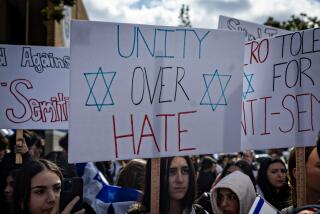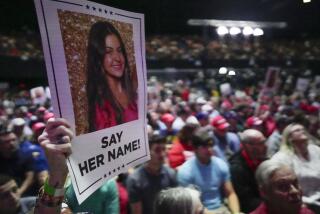Two Cases Renew Concern Over Hate Crimes : Brutality: A white woman was murdered; a black man was torched. To many, racially motivated violence seems like a throwback to the days of lynchings generations ago. But is it?
- Share via
NORTH CHARLESTON, S.C. — People can’t stop talking about the crimes, partly because of their brutality--a woman here gang-raped and murdered, a man in Florida doused with gasoline and set afire--but also because of a question that makes folks shudder.
Were the victims singled out because of their race?
In the Tampa case, the victim was black and all three suspects white. Here, the victim was white and all eight suspects black.
“I’d like to know what they were thinking,” said Mike Kelley of North Charleston, who lives a few trailers down from the scene of the rape and knew some of the suspects as neighbors. He and others shook their heads while discussing the case on a recent rainy evening.
To many in the South and elsewhere, racially motivated crimes seem like throwbacks to the days of lynchings generations ago, or to more recent times when official segregation created suspicion, tension and hatred between blacks and whites.
“We’ve come a long way,” insisted Frank Binarr, another disbelieving neighbor here. “Whites and blacks get along.”
Even if that is broadly true, racially motivated violence is nonetheless on the rise, the numbers indicate.
More than 50 murders across the United States in 1991 and ’92 were classified as hate crimes by Klanwatch, a research group in Birmingham, Ala., that has monitored hate group activity since 1979.
“Hate crimes used to be strictly white on black. Now, it’s every racial group,” said Klanwatch researcher Angie Lowry. As she worked on an analysis of 1992 data, she said, “Hate crimes in just about every category are up.”
A just-released study of 10 cities’ 1992 police figures found a 24% rise in bias crimes from 1991. The study, prepared for the Los Angeles law firm Stroock & Stroock & Lavan, was part of a U.S. Supreme Court brief in defense of a Wisconsin law increasing penalties for hate-motivated crimes.
In some ways, the Florida and South Carolina crimes were mirror images, with numerous eerie parallels but the races of victims and attackers reversed.
Both victims, authorities say, were chosen at random.
Christopher Wilson, 31, a black New York tourist, was abducted at gunpoint from a Tampa-area shopping center on New Year’s Day. Police say he was driven to an isolated area, robbed, doused with gasoline and set ablaze.
Burned over 40% of his body, he remains hospitalized. Three white men who worked in a local labor pool have been charged with attempted murder.
Just two days earlier in North Charleston, police say, 25-year-old Melissa McLauchlin was abducted while walking across a street, taken to a trailer park, raped by at least five men, then driven out of town, shot six times and dumped on a rural road.
Five men have been arrested and a sixth is being sought on murder, rape and related charges; two women have been charged as accessories. All the suspects are black.
In each case, there is chilling evidence that race was at least part of the motive.
In Tampa, investigators found a note that read: “One less nigger, one more to go.” It was signed “KKK,” but the suspects have denied being part of any hate group and Ku Klux Klan officials have denied involvement.
Wilson told police that his abductors taunted him with racial slurs; FBI agents are looking into possible civil rights charges.
In South Carolina, detectives believe race was a motive for at least two of McLauchlin’s attackers. “There’s no question that they were looking for a white woman,” said Police Detective C. W. (Butch) Henerey, noting that others involved had unrelated motives that he would not specify.
One suspect, Matthew Mack, reportedly told police the attack was in response to “400 years of oppression” since slaves arrived in the United States.
In the car believed to have been used in the abduction, authorities also found a written document. Police said it contained “some profound racial language--talking about oppression by whites against blacks,” according to Harve Jacobs, a North Charleston city spokesman.
To Henerey, such reasoning is “so outlandish and unbelievable in this day and age, that somebody could go to this extent because of the color of somebody’s skin.”
No hate group has been tied to the crime.
“These guys were not part of any organization,” said Joe D. Kennedy, a special agent of the Naval Investigative Service, which is helping police. Two of the suspects were active-duty sailors, two were discharged from the Navy for drug infractions, but none were known to have been involved in any racial incidents in the service, Kennedy said.
In Florida and South Carolina, reaction to the crimes--from both blacks and whites--has been the same: revulsion.
“One of the leads that came in early and helped break this case wide open was a telephone call--and it came from a black female,” Henerey said.
“Sick,” said Pam Baldwin, a black customer at a coffee shop, when asked her thoughts on a possible racial reason behind the rape-killing. “How could somebody go around with such an attitude?”
Researchers have tried for years to find answers. Hate crimes differ in many ways from other crimes, they’ve found.
First, they are more personal. While only 11% of all crimes are assaults, the rest being against property, more than a third of hate crimes are assaults, according to Brian Levin, a lawyer and bias crime researcher in Los Angeles.
And research has shown bias-motivated assaults are more brutal, their victims three times as likely to require hospitalization.
“I think there’s a reason for that: With this crime, the violent act is not the byproduct, but the goal,” Levin said.
Sending a message is the deeper goal, said Jack McDevitt, a criminologist at Northeastern University in Boston who has helped the FBI train police in handling hate crimes. When victims are chosen at random because of their race, he said, “The message is to everyone in that group: ‘You don’t belong.’ ”
Hate crimes are most often committed by people who feel that their “turf”--neighborhood, workplace, school--is being invaded, or because of a sense of losing social or economic status, McDevitt said. “People look for somebody to blame,” he said.
Other triggering factors cited by Levin include the Rodney G. King case in Los Angeles, continuing negative racial stereotypes and a growing acceptance of violence to settle disputes.
Data indicate that about two-thirds of hate crime offenders are white and one-third black, McDevitt said.
“People want to believe this is something we’ve left behind, but we haven’t,” he said.
In the Florida and South Carolina cases, the victims’ parents spoke out but were unable to make sense of the crimes.
Wilson’s mother, Enid Plummer, wanted a photograph of her son’s injuries.
“I want everyone to see what people are capable of doing over skin color,” she told reporters. “I want people to see how ugly racism is.”
McLauchlin’s father, Clair McLauchlin, in a statement urged calm, but said explanations of the crime rang hollow and called for the killers to be executed.
“The fact that it is labeled as a hate crime or racial incident,” he said, “doesn’t make any difference.”
More to Read
Sign up for Essential California
The most important California stories and recommendations in your inbox every morning.
You may occasionally receive promotional content from the Los Angeles Times.













